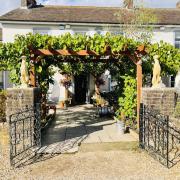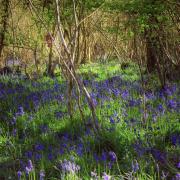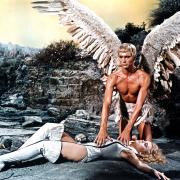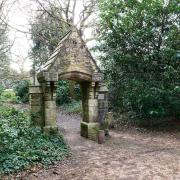Do you know your witch bottle from your soul cake? Jerry Bird reveals the Dorset customs that were believed to keep witches and wandering spirits at bay during Hallowe'en
Hallowe’en, or All Hallows’ Eve, has its origins in the pre-Christian Celtic festival of the dead, called Samhain (pronounced Sow-ain). The Celtic year began on November 1 ― when livestock was secured for the winter months, or slaughtered and salted down to provide food for this time of year. The date marked both an ending and a beginning in an eternal agricultural cycle. Sacred fires were lit, and people gathered to sacrifice animals, and feast on seasonal fruits, nuts and vegetables.
The Celts believed that at this, more than any other time of the year, the spirits of the dead were able to mingle with the living; the ‘veil between the worlds’ being at its thinnest. Throughout the Middle Ages and beyond, people believed that at Hallowe’en all manner of supernatural beings were abroad, especially ghosts, fairies, and witches. Along with the fires, candles were lit and carried in procession to keep these undesirables away. The familiar Hallowe’en jack-o’-lantern was carved each year from turnips or mangolds for this purpose.

The Church, unable to eradicate the pagan festival, instigated the feasts of All Saints (November 1) and All Souls (November 2), in which the living prayed for the souls of the dead. This was meant to replace Samhain and draw the devotion of the Celtic people. Though that never quite happened, by the late-medieval period the old gods were largely forgotten, and their sacrifices were reduced to divination involving roasting nuts in the embers of a fire, and games such as apple-bobbing.
Church bells were rung on All Hallows’ Eve, sometimes all through the night. William Hone, in his Every Day Book (1826) notes that this had been the custom in Blandford Forum up to the Reformation, when such ‘superstitious practices’ were banned, and All Souls’ Day was dropped from the Church calendar.
However, the wandering spirits were never forgotten. In Victorian and Edwardian times, wine and cakes were left overnight for lost souls, and on November 1 the rural poor and their children would go from door to door ‘souling’ (singing songs to be rewarded with cake, money or whatever was on offer). Later in the 20th century, to the dismay of many, this old English tradition was reimported from America as ‘trick or treating’ - children demanding sweets with menaces, dressed as cartoon witches and monsters.

A traditional ‘soul-caking’ song, collected from just over the border in Somerset in the 19th century, had the lines:
A soul, a soul for a soul cake
One for Jack Smith,
And one for Tom White
And one for myself and I’ll bid you goodnight.
My clothes are ragged
My shoes are very thin
I’ve got a little pocket
To put three halfpence in
And I’ll never come souling
Till another year.
Soul cakes were a cross between a scone and a biscuit, spiced and often decorated with currants in the shape of a cross. In some places the ‘soul-cakers’ performed a short play, very like a mummers play — a tradition which continues in Antrobus, Cheshire to this day.
All Souls’ Day was restored to the Church of England’s calendar in 1928, at a time when superstition about witches and ghosts was no longer considered a danger. However, with its recent rise in popularity many evangelical Christians, especially in the US, virulently oppose Hallowe’en celebrations, seeing them as a manifestation of evil. Though who is the more superstitious - the celebrants or their opponents – is debatable!
Of all the modern-day Hallowe’en celebrations the most serious are the annual ceremonies attended by today’s Pagans, Wiccans, witches and Druids, who gather together on All Hallows’ Eve to mark the turning of the year and to honour the old gods and our Celtic ancestors with dignified rituals, cakes and wine.
In Dorset there was always a strong association between fairies and witchcraft. When John Walsh, a ‘cunning man’ from Netherbury in the 1560s who practised herbal cures and magic, was accused of witchcraft, he admitted that he sought advice from fairies. There were, he said, three kinds of fairies — white, green and black, of which the black ‘be the worst’. He consorted with them on ‘large heapes of earthe’, in other words the ancient burial mounds which dot the landscape of West Dorset.
Charms designed to keep witches and fairies away from households and farms often take the form of ‘witch bottles’ - these have been found in houses in places such as Cheselbourne, Sixpenny Handley, Sturminster Newton, Stalbridge, Worth Matravers and Winterborne Kingston.

Of the latter, Marianne Dacombe wrote in 1935: ‘a bottle was found hanging by a wire up in the old chimney; and, when it was cut down, was found to contain liquid. It was tightly corked and the cork stuck all over with pins. After the bottle was broken and the liquid spilled the family had nothing but bad luck and finally left the place. The bottle is supposed to prevent bad spirits entering the house.’
The bottles were often ‘bellarmine jars’ (which featured a bearded face on the neck) and the contents usually included bent pins, hair, nail clippings and urine.
Other charms took the form of a bullock’s heart studded with nails and thorns and hung in the chimney above the fire grate. An example was found when a new fire grate was fitted at Frampton Police Station around 1900. The use of such charms is known by folklorists as ‘apotropaic magic’. Folklorist Jeremy Harte wrote that while originally designed as a counter-charm against witchcraft, by the early 19th century the pin-studded bullock’s heart ‘was being used as an all-purpose talisman against malicious things coming down the chimney-breast’. It is not unlikely that such charms were checked before each Hallowe’en night and replaced if necessary.

Other apotropaic charms common in Dorset included nailing a horseshoe to a stable door, to prevent a horse being ‘hag-ridden’ in the night. Stones with holes in, known as ‘hag stones’, served a similar purpose; they were popular with Weymouth fishermen, who tied them to the prows of their boats, presumably to prevent their nets being cursed. A single shoe was sometimes placed on a ledge in the chimney breast, and sometimes in the rafters of a house; leaving a besom (a broom made of furze) across a dairy door was believed to prevent witches crossing the threshold and spoiling the milk. Some of these charms, such as the horseshoe, are now regarded good luck charms.

The Samhain bonfires were shifted to November 5 by Royal decree, as a national celebration of the failure of Catholic sympathisers to blow up both King and Parliament in 1605. Thomas Hardy describes just such a bonfire at Rainbarrow near Puddletown, in The Return of the Native (1878):
‘The flames from funeral piles long ago kindled there had shone down upon the lowlands as these were shining now. Festival fires to Thor and Woden had followed on the same ground and duly had their day. Indeed, it is pretty well known that such blazes as this the heathmen were now enjoying are rather the lineal descendants from jumbled Druidical rites and Saxon ceremonies than the invention of popular feeling about Gunpowder Plot.’
Click here for our spooky pumpkin soup recipe
Many modern-day Pagans are enthusiastic supporters and organisers of the various bonfire societies (especially in Sussex) that stage the fiery celebrations around November 5, and are reclaiming the bonfire tradition from Guido Fawkes and King James I. {end square here}
Jerry Bird is a professional writer and musician living in Dorset. He edits, and is the major contributor to, Merry Meet Magazine, a thrice-yearly journal of folklore and pagan heritage.




























